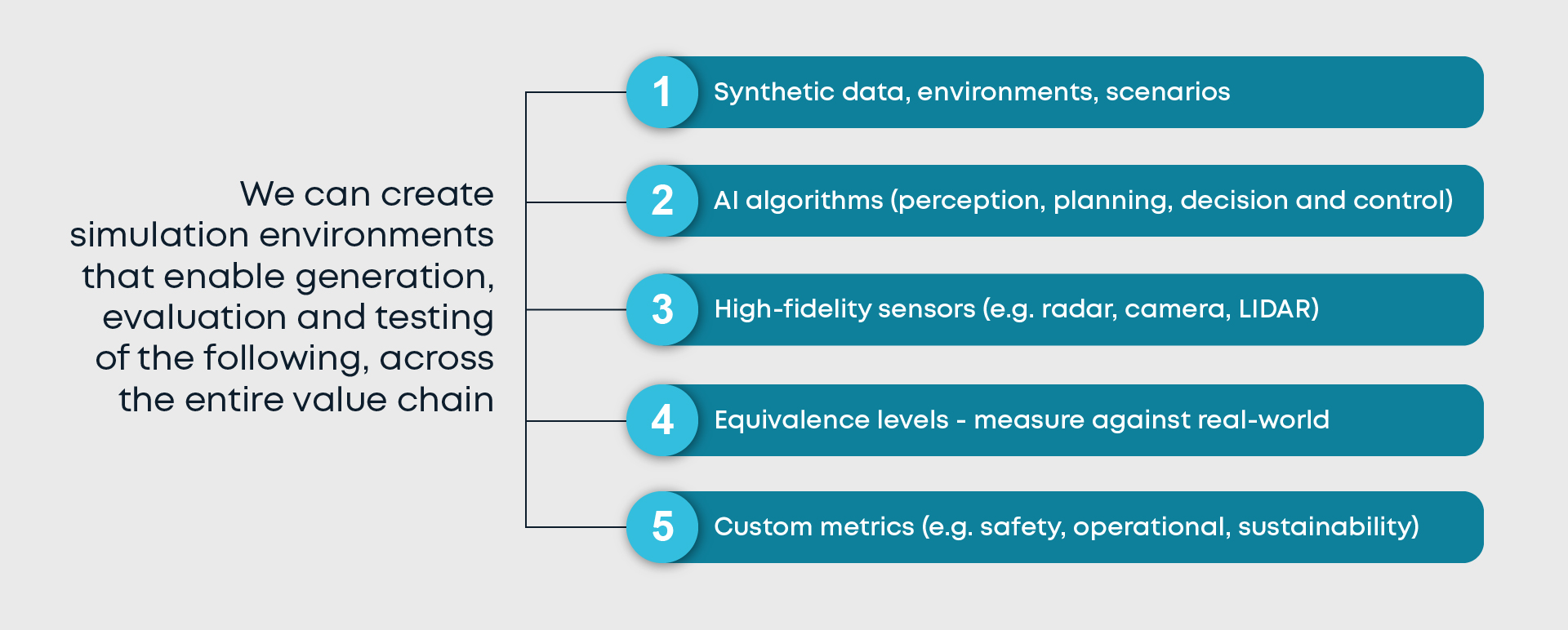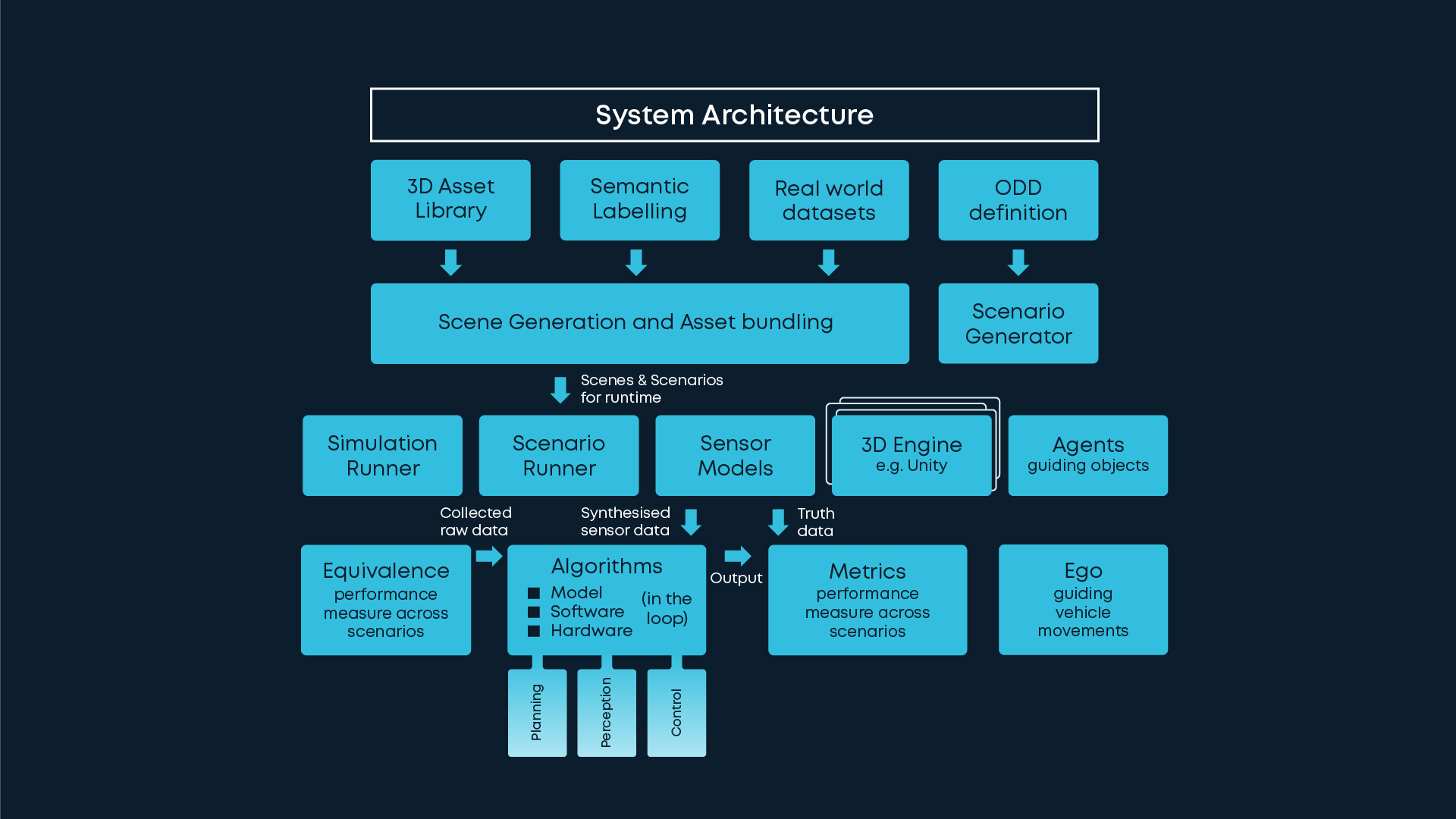- Equivalence
- Simulated Sensors
- Scenario Based Validation
- Example 1: Warehouse automation
- Example 2: Flow analysis for smart roads
- Example 3: Algorithm performance verification
- Example 4: EV Fleet Modelling
- Modularity
- Simulation Architecture
- VR
- Example 1 - Human reaction testing
- Example 2 - Dynamic navigation testing
- Example 3 - User experience testing
Simulation Capabilities
- Equivalence
- Simulated Sensors
- Scenario Based Validation
- Example 1: Warehouse automation
- Example 2: Flow analysis for smart roads
- Example 3: Algorithm performance verification
- Example 4: EV Fleet Modelling
- Modularity
- Simulation Architecture
- VR
- Example 1 - Human reaction testing
- Example 2 - Dynamic navigation testing
- Example 3 - User experience testing
- Contact Us
Deploying large-scale technology without compromising performance requires significant resources and capital, but our intelligent simulations offer a cost-effective solution that delivers a competitive edge across industries.
Proven to reduce 95% real-world data collection costs, powered by our unique approach using simulations with measurable equivalence to real-world.
Enable a huge expansion of test scenarios, and provides the required confidence to use the outputs as validated evidence in a safety case.
Accelerate product development with virtual testing on full autonomous stacks, resulting in faster and more efficient processes, reducing lag times throughout the entire ecosystem.

Equivalence
- Simulated Sensors
- Scenario Based Validation
- Example 1: Warehouse automation
- Example 2: Flow analysis for smart roads
- Example 3: Algorithm performance verification
- Example 4: EV Fleet Modelling
- Modularity
- Simulation Architecture
- VR
- Example 1 - Human reaction testing
- Example 2 - Dynamic navigation testing
- Example 3 - User experience testing
- Contact Us
Our simulation environment is built with an equivalence module at its core. Equivalence is a technique for measuring the discrepancy between a simulated environment and its real world equivalent by using performance measurements on an algorithm that is going to operate on data sensed in that 3D environment.
Trust in the outputs is paramount in order to have confidence in simulating critical business decisions and validating safety parameters.
1.
Understand Objectives
2.
Collect Data
3.
Resimulate scene
4.
Measure equivalence
5.
Reduce Error
6.
Simulate
Simulated Sensors
- Scenario Based Validation
- Example 1: Warehouse automation
- Example 2: Flow analysis for smart roads
- Example 3: Algorithm performance verification
- Example 4: EV Fleet Modelling
- Modularity
- Simulation Architecture
- VR
- Example 1 - Human reaction testing
- Example 2 - Dynamic navigation testing
- Example 3 - User experience testing
- Contact Us
Radar is a pivotal sensor to unlock reliable and cost-effective full stack autonomy. Combining this with lidar and camera provides you a full suite of potential autonomous sensors.
These establish performance more easily before committing to build or evaluate potential providers and reduce real world data collection costs.
Scenario Based Validation
It is nearly impossible to recreate all the possible scenarios required to validate autonomous solutions in the real-world.
Generating scenarios enables running thousands of simulated scenes as part of millions of specific scenarios, allowing fast virtual design iteration often before the physical build.
Example 1: Warehouse automation
The importance of this simulation was to understand the trade offs between 3 potential ways of loading planes using automation. We use real physics implementations to measure KPIs like throughput, efficiency, and shock.
The outputs of the simulations can then be used in early business justifications for large-scale capital decisions - in this case, how many planes to order.
Example 2: Flow analysis for smart roads
In this example we simulated overall traffic flow as we transition from human drivers to autonomous vehicles.
We found autonomous driving reduces congestion as expected. However, if car manufacturers work together on setting parameters such as risk tolerance, global congestion can be reduced by a further 1-3%.
Example 3: Algorithm performance verification
In this example, we're measuring the performance of a Simultaneous Location And Mapping (SLAM) algorithm that uses stereo camera sensors to build up an internal map of the vehicle's environment, in different environmental conditions.
In this case, the algorithm struggled to meet 'all of the spec all of the time' - the simulation accelerates development of a more robust algorithm and shows where mitigations are required to meet the safety case.
Example 4: EV Fleet Modelling
In this simulation of a fully electric London bus fleet we model existing TfL routes and the future charging ecosystem
We can use this to explore:
- Battery Health and TCO
- Impact of pantograph charging
- V2G, Flexibility, and charge sharing revenue opportunities
- Depot location optimisation
- Grid requirements
- Impact of variability in drivers, tyre health, passenger load, route elevation...
We can also use the synthetic data from the simulations to train algorithms for optimising charging, routes, or locations
- Equivalence
- Simulated Sensors
- Scenario Based Validation
- Example 1: Warehouse automation
- Example 2: Flow analysis for smart roads
- Example 3: Algorithm performance verification
- Example 4: EV Fleet Modelling
Modularity
With modular architectures, we can be adaptive for specific use cases and requirements. This allows for flexibility by swapping relevant modules which will increase interactions so that the ecosystem can work together towards common system performance goals.
Traditional Architecture
Modular Architecture
Simulation Architecture
Our simulation architecture is built upon fundamental building blocks that can be utilized and adapted to suit your specific needs. You can even swap in or out modules as required, reducing redundancy while enabling smooth integration with larger ecosystems.

- Equivalence
- Simulated Sensors
- Scenario Based Validation
- Example 1: Warehouse automation
- Example 2: Flow analysis for smart roads
- Example 3: Algorithm performance verification
- Example 4: EV Fleet Modelling
- Modularity
- Simulation Architecture
VR
What happens when people need to be “in the loop autoplay” of the simulated test environment? Using VR we can test this not only for safety benefits such as AI assurance, but also to cost effectively reach a wider test audience.
Example 1 - Human reaction testing
Here we created dangerous level 3 autonomy driving scenarios in the simulator which require handover of control from an AD algorithm to human to determine whether their response is worse compared to them having been driving the whole time.
Example 2 - Dynamic navigation testing
Here we tested how a robot can adapt to changing scenarios. VR can be used as a tool to get a more realistic simulation of the human in the environment.
Example 3 - User experience testing
Here we validated the overall proposition from a wide set of users. This allowed us to iterate different designs and prioritise features without the need for physical prototyping, complex logistics in a rapid and geographically scalable way.
- Equivalence
- Simulated Sensors
- Scenario Based Validation
- Example 1: Warehouse automation
- Example 2: Flow analysis for smart roads
- Example 3: Algorithm performance verification
- Example 4: EV Fleet Modelling
- Modularity
- Simulation Architecture
- VR
- Example 1 - Human reaction testing
- Example 2 - Dynamic navigation testing
- Example 3 - User experience testing
Contact Us
Our intelligent simulation can bring a competitive advantage, save money and increase business value for clients across multiple industries.
Do you want to explore how 3D simulation can enhance your development journey?
Get in touch

